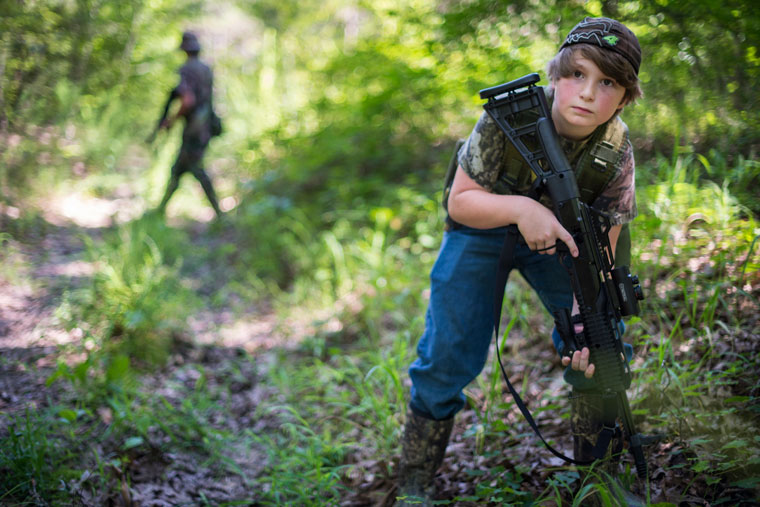Citing the Constitution, groups prepare to defend themselves and their rights
Fear of the federal government’s interference with Second Amendment rights and suspicion that elected officials are ignoring the “will of the people” have provoked a resurgence of self-described patriots across the country who say they are preparing to defend themselves and their rights by any means necessary.
Organizations tracking the movement say the number of groups has risen dramatically in the past six years.
“There’s a very unreasonable, ridiculously crazy attack on the Second Amendment and people that own guns,” said Cope Reynolds, a member of the White Mountain Militia in Show Low, Arizona. “If everything were not protected by the Second Amendment, the government would have the opportunity, if they so desired, to go unchecked with impunity and do whatever they want to do.”
Reynolds is the operations manager of Shots Ranch, a tactical shooting range and survival training facility in Kingman, Arizona. He considers this type of training to be necessary preparation for a time in America he sees as inevitable.
“We want people to be able to provide for themselves in a world where we might not be able to just run down to Wal-Mart at any time,” Reynolds said. “We think that at some point in America we’re probably going to experience those times and a lot of us think it’s not going to be far away.”
For individuals like Reynolds, the Second Amendment is an important check on the government and is needed to protect the Constitution.
“It’s the beauty and the danger of America’s Constitution,” said Adam Winkler, a law professor at the University of California, Los Angeles, and a Second Amendment expert. “Its great generalities are so vague that anyone can interpret them in light of their own experience and their own interests. And indeed, the Second Amendment is one of the most confusing textual provisions of the Constitution.”
In 2008, the U.S. Supreme Court ruled in District of Columbia v. Heller that the Second Amendment protects an individual right to own a firearm for traditionally lawful purposes like self-defense.
“It has certainly given fuel to gun rights proponents and to gun culture,” said Robert Spitzer, a political scientist, author and professor at State University of New York Cortland who specializes in gun issues. “It fortified, in a very specific way, the very idea that there is in law something called gun rights.”
Mississippi Militia
The 2008 ruling held that the individual right to own a firearm is “unconnected with service in a militia.”
“There certainly is a belief, and it’s a long-standing belief, that somehow average citizens owning guns will somehow have a beneficial or therapeutic effect on government behavior,” Spitzer said. “It’s rooted in anti-government sentiment, which has a very long history in the U.S.”
Reynolds disagrees.

Cope Reynolds manages the operations at Shots Ranch, a tactical training facility in Kingman, Ariz. Photo by Jim Tuttle/News21.
“We’re not anti-government. We’re anti-corruption in government. There’s a huge difference,” he said. “We cannot survive without government. We would turn into probably one of the most savage nations on the planet with no government at all.”
The Southern Poverty Law Center identified 1,096 “anti-government” patriot groups in the U.S. in its 2013 Intelligence report, an increase from about 150 groups in 2008. Considered part of this movement are 240 militia groups, which the center says have made a resurgence since their earlier popularity in the mid-1990s.
Mark Pitcavage, director of investigative research for the Anti-Defamation League, also has been studying the militia movement for the past 20 years and says the numbers are higher. The ADL keeps an internal list of militia groups, but does not publish it.
“We were tracking around 50 active militia groups in 2008 and now we’re tracking between 250 and 300 active militia groups,” he said. “It certainly represents a serious surge, which we’re able to confirm through the presence of groups and individuals on social networking sites, the number of militia-related events and trainings that we count each year.”
Pitcavage said the last militia movement was sparked in part by events in Ruby Ridge, Idaho and Waco, Texas, sieges that tuned in to deadly standoffs with federal agencies. He noted a similarity between these events and the standoff between Cliven Bundy and the Bureau of Land Management earlier this year in Bunkerville, Nevada.
Bundy had been in a disagreement with the government over more than $1 million in grazing fees and fines owed to the federal government. When the BLM came to seize his cattle in April, many militia groups and other members of the patriot movement joined his resistance, aiming their weapons at federal officers until the BLM withdrew.
“Here’s someone involved with conflict with the government and the government shows up at his ranch and starts taking his cattle that have been illegally grazing off the property,” Pitcavage said. “That’s tailor made for the militia movement.”









